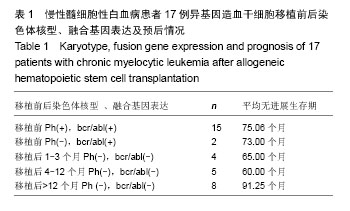| [1] Mauro MJ,Mazia RT.Stem cell transplantion in Patients with chronic myelogenous leukemia: When should it beused? Mayo Clin Proc.2006;81(3):404-416.[2] Huttunen P,Taskinen M,Siitonen S,et al.Impact of very early CD4(+) /CD8(+) T cell counts on the occurrence of acute graft-versus-host disease and NK cell counts on outcome after pediatric allogeneic hematopoietic stem cell transplantation.Pediatr Blood Cancer.2015;62(3):522-528. [3] 童春,郭智,楼金星,等.异基因造血干细胞移植后T淋巴细胞亚群监测的临床意义[J].中国实验血液学杂志, 2016,24(1):167-172.[4] Miano M,Dufour C.The diagnosis and treatment of aplastic anemia: a review.Int JHematol.2015;101(6):527-535.[5] Im HJ,Koh KN,Seo JJ.Haploidentical hematopoietic stem cell transplantation using ex vivo T cell-depleted grafts in pediatric patients.Blood Res.2016;51(1):8-16. [6] 童春,郭智,楼金星,等.单倍型异基因造血干细胞移植治疗重型再生障碍性贫血:回顾性分析[J].中国组织工程研究,2015,19(36): 5821-5826.[7] Ahmed RK,Poiret T,Ambati A,et al.TCR+CD4-CD8- T cells in antigen-specific MHC class I-restricted T-cell responses after allogeneic hematopoietic stem cell transplantation.J Immunother. 2014;37(8):416-425. [8] .Horch M,Nguyen VH.Regulatory T-cell immunotherapy for allogeneic hematopoietic stem-cell transplantation.Ther Adv Hematol.2012;3(1):29-44.[9] Esteves I,Bonfim C,Pasquini R,et al.Haploidentical BMT and post-transplant Cy for severe aplastic anemia: a multicenter retrospective study.Bone Marrow Transplant.2015; 50(5): 685-689. [10] Wang Z, Zheng X,Yan H,et al.Good outcome of haploidentical hematopoietic SCT as a salvage therapy in children and adolescents with acquired severe aplastic anemia.Bone Marrow Transplant. 2014;49(12):1481-1485. [11] Clay J,Kulasekararaj AG,Potter V,et al.Nonmyeloablative peripheral blood haploidentical stem cell transplantation for refractory severe aplastic anemia.Biol Blood Marrow Transplant. 2014;20(11):1711-1716. [12] Yoshida N,Kobayashi R,Yabe H,et al.First-line treatment for severe aplastic anemia in children: bone marrow transplantation from a matched family donor versus immunosuppressive therapy. Haematologica.2014; 99(12): 1784-1791.[13] Bacigalupo A.Bone marrow transplantation for acquired severe aplastic anemia.Hematol Oncol Clin North Am. 2014;28(6):1145-1155. [14] 吴薇,韩瑞玲,张力,等.RQ-PCR在慢性粒细胞白血病细胞BCR-ABL融合基因检测中的应用[J].检验医学与临床, 2016, 13(22):3133-3137.[15] Ali MA.Chronic Myeloid Leukemia in the Era of Tyrosine Kinase Inhibitors: An Evolving Paradigm of Molecularly Targeted Therapy.Mol Diagn Ther.2016;20(4):315-333. [16] Li Q,Wu Y,Fang S,et al.BCR/ABL oncogene-induced PI3K signaling pathway leads to chronic myeloid leukemia pathogenesis by impairing immuno-modulatory function of hemangioblasts.Cancer Gene Ther. 2015;22(5):227-237. [17] NCCN.Clmical practice Guidelines in oncology[EB/Ol]Version 1.2016.http:www.nccn. org/professionals/physiciangls/guidelines.[18] 秘营昌,罗成伟,MIYing-chang,等.异基因干细胞移植与化疗作为急性髓系白血病缓解后治疗的前瞻性配对研究[J].循证医学, 2015,15(2):79-82.[19] Algra SO,Kornmann VN,van der Tweel I,et al.Increasing duration of circulatory arrest, but not antegrade cerebral perfusion, prolongs postoperative recovery after neonatal cardiac surgery.J Thorac Cardiovasc Surg.2012;143(2): 375-382. [20] 李正发,沈晓梅,朱宝生,等.慢性髓细胞性白血病的细胞遗传学与预后的临床分析[J].中国肿瘤临床,2002,29(9):665-667.[21] 钱思轩,李建勇,潘金兰,等.荧光原位杂交技术在异性间造血干细胞移植后Ph阳性白血病的检测意义[J].中华内科杂志,2006, 45(3):234-236.[22] 孟昭彦,温莉娟,刘丽明,等.应用荧光原位杂交技术检测慢性粒细胞白血病的融合基因[J].中国优生与遗传杂志,2011,19(2): 21-22.[23] 李素霞,达万明,高春记,等.异基因造血干细胞移植后嵌合体检测的研究[J].中国医师杂志,2005,7(7):908-909.[24] 李正发,沈晓梅,朱宝生,等.白血病患者异基因造血干细胞移植后细胞遗传学标志的临床观察[J].中国医师杂志,2007,9(10): 300-1303.[25] 朱宝生,沈晓梅,李惠民,等.三例变异型Ph染色体的bcr/abl融合基因荧光原位杂交[J].中华血液学杂志2001,22(7):383.[26] 宋阿霞,杨栋林,魏嘉璘,等.异基因造血干细胞移植治疗进展期慢性髓系白血病疗效及预后的初步分析[J].中国实验血液学杂志, 2011,19(1):149-153.[27] 李正发,邓明倩,沈晓梅,等染色体核型和bcr/abl融合基因表达与慢性髓细胞白血病急变的关系[J].昆明医学院学报,2012,33(1): 12-15. |
.jpg)



.jpg)
.jpg)